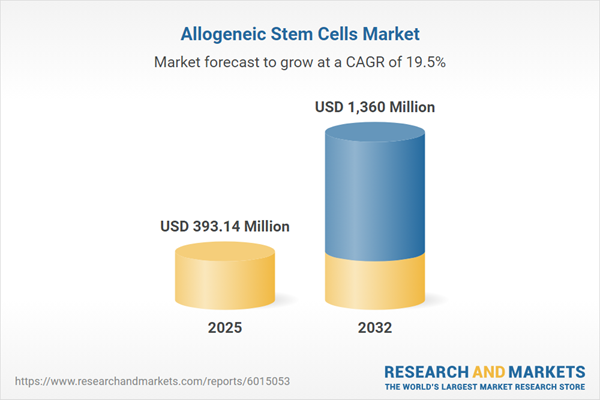Speak directly to the analyst to clarify any post sales queries you may have.
Allogeneic stem cell therapies are at the forefront of regenerative medicine, enabling organizations to access standardized, scalable solutions that enhance care delivery across a variety of clinical settings. These therapies are transforming the landscape by supporting organizations in strengthening operational efficiency and delivering reliable, advanced treatment pathways.
Market Snapshot: Allogeneic Stem Cells Market Overview and Growth
The global allogeneic stem cells market is experiencing rapid expansion, driven by increasing availability of ready-to-use therapeutic options and growing acceptance of donor-derived treatments. Demand is robust in areas such as immunology, orthopedics, and cardiology, with key collaborations among pharmaceutical, biotechnology, and manufacturing stakeholders accelerating innovation. Strategic moves toward workflow standardization and improved product quality continue to encourage organizations to choose allogeneic over autologous approaches. Senior decision-makers benefit from a dynamic market that rewards quality, scalability, and streamlined integration of cutting-edge solutions.
Scope & Segmentation of the Allogeneic Stem Cell Market
This analysis presents the crucial segments and innovation drivers shaping the allogeneic stem cell market. Understanding each area supports informed strategic planning and optimal investment.
- Tissue Types: Hematopoietic stem cells sourced from bone marrow or peripheral blood, and mesenchymal stem cells obtained from adipose tissue, bone marrow, or umbilical cord, broaden the spectrum of clinical and research possibilities.
- Applications: Diverse organizational use cases cover cardiovascular repair, advanced immunotherapy including CAR-T and NK cell treatments, neurological disorder management, orthopedic interventions, and wound healing.
- Sources: Adipose tissue, bone marrow, umbilical cord, and peripheral blood allow organizations to align procurement with operational priorities.
- Product Forms: Formats such as cryopreserved, freeze-dried, and fresh enable customization of distribution, storage, and clinical activities to meet the needs of both large networks and specialized facilities.
- End-Users: Contract manufacturers, hospitals, specialty clinics, and research institutes are critical contributors to therapy deployment and ongoing clinical progress.
- Distribution Channels: Direct sales, specialized distributors, and evolving digital channels extend global accessibility for healthcare professionals and researchers.
- Regions Covered: Key growth is seen across the Americas, Europe, Middle East & Africa, and Asia-Pacific, each with unique regulatory environments and adoption patterns. Leading countries include the United States, Canada, Germany, Japan, and China, providing granular insights and diverse market opportunities.
- Technology Innovations: The adoption of gene editing tools, automated bioreactor systems, and advanced quality analytics tools are all enhancing compliance, supporting scale-up, and facilitating competitive positioning for forward-looking organizations.
- Key Companies Profiled: Major sector participants such as Mesoblast Limited, Pluristem Therapeutics, Athersys, Gamida Cell, Cynata Therapeutics, Fate Therapeutics, Allogene Therapeutics, Celularity, TiGenix, and Osiris Therapeutics drive industry evolution and maintain a steady focus on continuous development.
Key Takeaways for Senior Decision-Makers
- Standardized allogeneic stem cell therapies offer consistent clinical outcomes, simplifying implementation in multi-site and system-wide programs.
- Expanding mesenchymal platforms complements established transplantation practices, enabling organizations to widen service portfolios and enhance clinical reach.
- Investing in automation and modular manufacturing allows for efficient scaling, seamless resource management, and increased collaboration between research, clinical, and manufacturing partners.
- Integrating sourcing, logistics, research, and clinical functions drives dependable therapy delivery across diverse regions and supports adaptable care models.
- Regulatory enhancements and active engagement between industry and public sector participants promote easier market entry and expanded adoption for allogeneic therapies.
Tariff Impact on the Allogeneic Stem Cell Market
Recent changes in U.S. tariffs affecting imported raw materials and specialized equipment have created cost management challenges within the allogeneic cell therapy segment. Organizations are responding by turning to local sourcing, diversifying supplier networks, and rethinking procurement strategies. Additionally, the use of alternative materials and bonded warehouses contributes to more resilient supply chains and supports sustained operational reliability.
Methodology & Data Sources
This report is based on a triangulated methodology, incorporating insights from expert interviews, targeted literature reviews, registry analyses, and supplier documents. Validation from sector-specific panels ensures that findings are accurate, practical, and relevant for decision-makers navigating regulatory and operational complexities.
Why This Report Matters
- Empowers senior leadership to advance strategic planning and investment initiatives in the allogeneic stem cell therapy market.
- Delivers an integrated understanding of market segmentation, technology trends, and regional variation to guide competitive positioning.
- Provides concise insights into regulatory, operational, and supply chain issues, enabling sound risk management and growth strategies.
Conclusion
Allogeneic stem cell therapies play a pivotal role as the healthcare industry continues to evolve. Sustained commitment to technology integration, regulatory responsiveness, and partnerships will remain fundamental to sector progress and organizational success.
Additional Product Information:
- Purchase of this report includes 1 year online access with quarterly updates.
- This report can be updated on request. Please contact our Customer Experience team using the Ask a Question widget on our website.
Table of Contents
3. Executive Summary
4. Market Overview
7. Cumulative Impact of Artificial Intelligence 2025
Companies Mentioned
The companies profiled in this Allogeneic Stem Cells market report include:- Mesoblast Limited
- Pluristem Therapeutics, Inc.
- Athersys, Inc.
- Gamida Cell Ltd.
- Cynata Therapeutics Limited
- Fate Therapeutics, Inc.
- Allogene Therapeutics, Inc.
- Celularity, Inc.
- TiGenix N.V.
- Osiris Therapeutics, Inc.
Table Information
| Report Attribute | Details |
|---|---|
| No. of Pages | 187 |
| Published | October 2025 |
| Forecast Period | 2025 - 2032 |
| Estimated Market Value ( USD | $ 393.14 Million |
| Forecasted Market Value ( USD | $ 1360 Million |
| Compound Annual Growth Rate | 19.4% |
| Regions Covered | Global |
| No. of Companies Mentioned | 11 |









